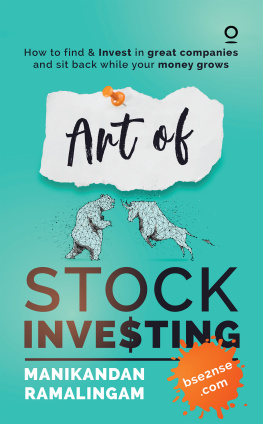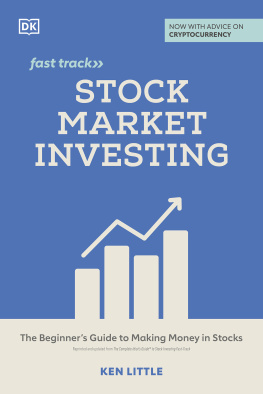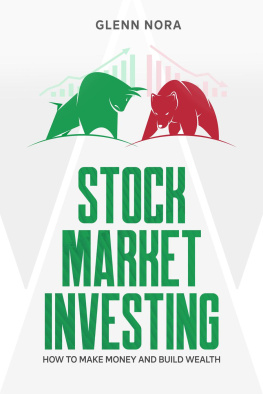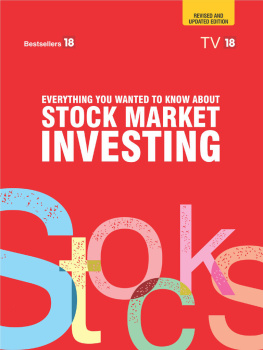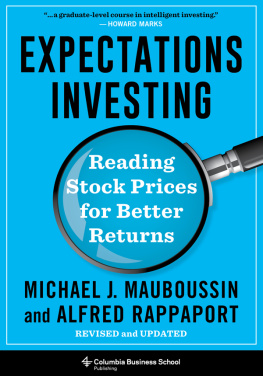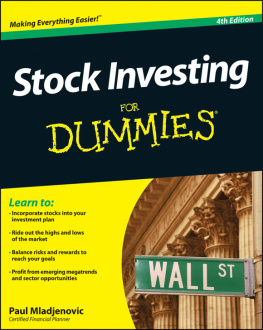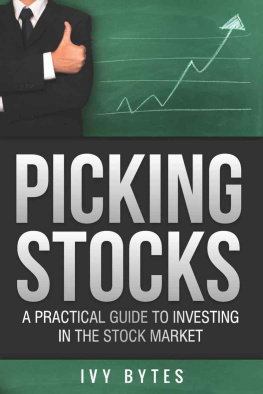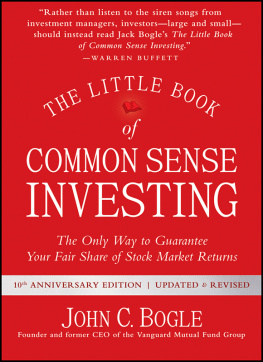Alfred Rappaport - Expectations Investing: Reading Stock Prices for Better Returns
Here you can read online Alfred Rappaport - Expectations Investing: Reading Stock Prices for Better Returns full text of the book (entire story) in english for free. Download pdf and epub, get meaning, cover and reviews about this ebook. year: 2003, publisher: Harvard Business Review Press, genre: Business. Description of the work, (preface) as well as reviews are available. Best literature library LitArk.com created for fans of good reading and offers a wide selection of genres:
Romance novel
Science fiction
Adventure
Detective
Science
History
Home and family
Prose
Art
Politics
Computer
Non-fiction
Religion
Business
Children
Humor
Choose a favorite category and find really read worthwhile books. Enjoy immersion in the world of imagination, feel the emotions of the characters or learn something new for yourself, make an fascinating discovery.

- Book:Expectations Investing: Reading Stock Prices for Better Returns
- Author:
- Publisher:Harvard Business Review Press
- Genre:
- Year:2003
- Rating:3 / 5
- Favourites:Add to favourites
- Your mark:
- 60
- 1
- 2
- 3
- 4
- 5
Expectations Investing: Reading Stock Prices for Better Returns: summary, description and annotation
We offer to read an annotation, description, summary or preface (depends on what the author of the book "Expectations Investing: Reading Stock Prices for Better Returns" wrote himself). If you haven't found the necessary information about the book — write in the comments, we will try to find it.
Expectations Investing: Reading Stock Prices for Better Returns — read online for free the complete book (whole text) full work
Below is the text of the book, divided by pages. System saving the place of the last page read, allows you to conveniently read the book "Expectations Investing: Reading Stock Prices for Better Returns" online for free, without having to search again every time where you left off. Put a bookmark, and you can go to the page where you finished reading at any time.
Font size:
Interval:
Bookmark:

expectations
investing
expectations
investing
reading stock prices
for better returns
ALFRED RAPPAPORT
MICHAEL J. MAUBOUSSIN
HARVARD BUSINESS SCHOOL PRESS
BOSTON, MASSACHUSETTS
Copyright 2001 Alfred Rappaport and Michael J. Mauboussin
All rights reserved
Printed in the United States of America
05 04 03 02 015 4 3 2 1
SVAR and SSVA are registered trademarks of L.E.K. Consulting LLC.
Requests for permission to use or reproduce material from this book should be directed to , or mailed to Permissions, Harvard Business School Publishing, 60 Harvard Way, Boston, Massachusetts 02163.
Library of Congress Cataloging-in-Publication Data
Rappaport, Alfred.
Expectations investing : reading stock prices for better returns / Alfred Rappaport, Michael J. Mauboussin.
p. cm.
Includes bibliographical references and index.
ISBN 1-57851-252-2 (alk. paper)
1. Investment analysis. 2. Portfolio management. 3. StocksPrices.I. Mauboussin, Michael J., 1964II. Title.
HG4529 .R37 2000
332.63'2042dc21
2001024378
The paper used in this publication meets the requirements of the American National Standard for Permanence of Paper for Publications and Documents in Libraries and Archives Z39.48-1992.
To Sharon
To Michelle
contents
greater expectations
how investing differs
from art collecting
Peter L. Bernstein
How does the capitalist system really work? In Capital, Karl Marx uses a remarkably simple equation to answer this question: M-C-M'. In words, the capitalist starts with Money, converts it into Capital, and ends up with More Money than he had originally. Note that money appears at both the beginning and the end of this equation. Note, also, that Marx does not describe a system in which the capitalist starts with money and then ends up with capital worth more than the original investment. Marx knew how to avoid that trap. If capital can never produce a flow of cash to its owners, then it is worthless, intrinsically and as a practical matter.
A century and a quarter after the publication of Capital, Jack Welch, the legendary CEO of General Electric and capitalist supreme, displayed his own recognition of M' as the driving force at GEalthough the intellectual roots of how he perceived the corporate goal might surprise him. In the companys 1995 annual report, Welch explained that GE was a company whose only answer to the trendy question, What do you intend to spin off? is cashand lots of it.
Al Rappaport and Michael Mauboussin also fully appreciate the overarching importance of cash. The seminal concept of M' forms the core of their extraordinary book. In crystal-clear language, they capture the full spirit of Marxs and Welchs emphasis on cash and employ it to develop a unique and powerful structure for investment strategies.
Had Marx limited his mathematical description of capitalism only to M-C, what purpose could such capital possibly serve? Without a monetary return, the owners of a firm could not pay for their groceries, opera tickets, Mercedes limousines, and Park Avenue apartments. Without money, they could pay for nothing. Even someone who would accept shares of a company as a stock dividend or in payment for a merger or acquisition would have to visualize a flow of cash somewhere, some time in the future. Any other expectation would be irrational; only people who collect objects like old stock certificates or works of art would expect anything else.
Indeed, without the prospect of cash flows, corporate assets would resemble bars of gold or zero-coupon bonds of infinite maturity, assets whose values are set only by the whims of the market (otherwise known as other investors), with no anchors, no tangibility, no meaning. I alluded above to art collectors to make this point: The process for pricing assets that will never produce a flow of cash to their owners parallels the process for valuing art or betting on horse races. Why is one painting worth millions of dollars and another worth a few hundred? No calculations can answer that question; the owner merely hopes that another art collector will step up to justify todays selling price at some point in the future.
Assets producing cash flows will ultimately return the owners investment without depending on the whims of other investors. Even if those cash flows are some distance in the future, their prospects endow them with a present value. Financial markets are nothing more than arenas where investors who need cash today can obtain it by selling the present value of future cash flows to other investors willing to wait for the cash payoffs from their capital. The payment medium in this transaction is money. The crucial point: If you invest without expecting future cash flows, then you might as well collect art or play the slot machines.
The tension in this book demands our attention. It focuses on future cash flows, but we never know for certain what the future holds. We cannot even count on the cash flows from U.S. Treasury obligationsperhaps less uncertain than other cash flows, but uncertain nevertheless. The fundamental law of investing is the uncertainty of the future.
How, then, can a rational investor derive the value of a future stream of cash, even a contractual one such as promised in a debt instrument? Rappaport and Mauboussin walk their way around this question by telling their readers not to answer it. I kid you not. Instead, the authors advise readers to let other investors answer the question! And their answers come through, loud and clear, in the prices paid for financial assets in the capital markets. As Rappaport and Mauboussin remind us repeatedly, stock prices (and bond prices, too) are a gift from the market, a gift of information about how other investors with money on the line are estimating the value of future cash flows.
If the markets generosity in providing key information were the whole story, then the authors would have written a pamphlet instead of a plump volume. But the market price is only the beginning, not the end. Investors still have hard work to do. We may be able to glean what other investors expect, but we should not accept those expectations without qualification. We must test the beliefs of the market, and here Rappaport and Mauboussin are at their best. They set forth a systematic testing process to guide the investor toward a reasoned judgment about both the company involved and the markets expectations, ultimately to determine whether to buy, sell, or hold.
Long experience in the capital markets reveals few lessons valid for all times; but, in half a century as a professional investor, I have found one particularly robust: The secret of success in maximizing the treasures of instruction in this book is silence. This important piece of advice to investors applies especially to Expectations Investing.
You need no ears to carry out the method recommended by Rappaport and Mauboussin. You can easily find everything you need, in print or on the Internet, specifically in market prices that reflect the views of investors willing to put their money where their mouths are, in publicly available corporate financial statements, and in the consensus forecasts published by reputable sources. Armed with this assemblage of data, you need not listen to the cacophony of recommendations flooding the investment community every minute of every day, no matter how exciting or lofty the sources of those recommendations. You can follow the actions of investors, not the
Next pageFont size:
Interval:
Bookmark:
Similar books «Expectations Investing: Reading Stock Prices for Better Returns»
Look at similar books to Expectations Investing: Reading Stock Prices for Better Returns. We have selected literature similar in name and meaning in the hope of providing readers with more options to find new, interesting, not yet read works.
Discussion, reviews of the book Expectations Investing: Reading Stock Prices for Better Returns and just readers' own opinions. Leave your comments, write what you think about the work, its meaning or the main characters. Specify what exactly you liked and what you didn't like, and why you think so.

